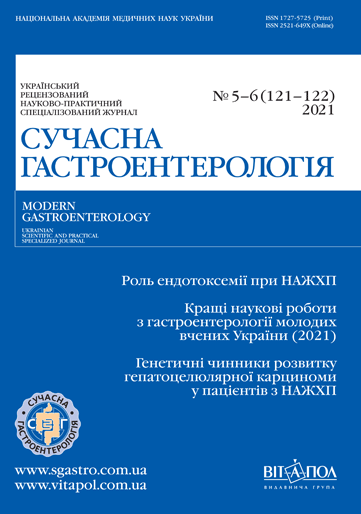Вплив генетичного поліморфізму на розвиток гепатоцелюлярної карциноми у пацієнтів з жировою хворобою печінки, асоційованою з метаболічним синдромом. Огляд літератури
DOI:
https://doi.org/10.30978/MG-2021-5-64Ключові слова:
гепатоцелюлярна карцинома, неалкогольний стеатогепатит, метаболічно‑асоційована жирова хвороба печінки, ризик генетичного поліморфізмуАнотація
В економічно розвинених країнах неалкогольна жирова хвороба печінки (НАЖХП) посідає перше місце серед захворювань печінки. У 2020 р. групою експертів запропоновано новий термін — «метаболічно‑асоційована жирова хвороба печінки», що дає змогу конкретизувати діагноз у пацієнтів, виділити фенотипи НАЖХП та оптимізувати лікування. Перебіг метаболічно‑асоційованої хвороби печінки може варіювати від легких форм (простий неалкогольний стеатоз, що характеризується накопиченням тригліцеридів у клітинах печінки) до агресивного перебігу з розвитком цирозу та гепатоцелюлярної карциноми. Агресивний перебіг захворювання спостерігається у пацієнтів з цукровим діабетом 2 типу, високим індексом маси тіла, абдомінальним типом ожиріння і стеатогепатитом, підтвердженим гістологічно. В епідеміологічних та генетичних дослідженнях виявлено зв’язок між морфологічною стадією метаболічно‑асоційованої хвороби печінки та спадковими чинниками. Прогресування до гепатоцелюлярної карциноми часто спостерігається у пацієнтів із виразним стеатогепатитом, хоча, за останніми літературними даними, частка пацієнтів з фіброзом F1—F2 і появою гепатоцелюлярної карциноми значно зросла. Це зумовлено наявністю метаболічного синдрому та генним поліморфізмом. Виділяють три основних гени, поліморфізм яких асоційований з розвитком метаболічно‑асоційованої хвороби печінки, інсулінорезистентністю, дисліпідемією та фіброгенезом, — PNPLA3, TM6SF2 і GCKR. Нещодавно був також ідентифікований поліморфізм гена MBOAT7, який особливо збільшує ризик розвитку стеатогепатиту у пацієнтів, що зловживають алкоголем і/або мають хронічний вірусний гепатит С. Виявлення поліморфізму зазначених генів є корисним для визначення груп високого ризику прогресування захворювання. Рання діагностика гепатоцелюлярної карциноми і стратифікація ризику дадуть змогу діагностувати захворювання на ранніх стадіях та оптимізувати лікування.
Посилання
Donati B, Dongiovanni P, Valenti L MBOAT7 rs641738 variant and hepatocellular carcinoma in non-cirrhotic individuals. Sci Rep. 2017;7 . 4492. doi: 10.1038/s41598-017-04991-0.
Dongiovanni P, Donati B, Fares R I148M PNPLA3 variant and progressive liver disease. World J Gastroenterol. 2013;19 (41):6969-6978. doi.org/10.3748/wjg.v19.i41.6969.
Dongiovanni P, Stender S, Pietrelli A et al. Causal relationship of hepatic fat with liver damage and insulin resistance in nonalcoholic fatty liver. J Intern Med. 2018;283:356-370. doi.org/10.1111/joim.12719.
Estes C, Anstee QM, Arias-Loste MT et al. Modeling NAFLD disease burden in China, France, Germany, Italy, Japan, Spain, United Kingdom, and United States for the period 2016-2030. J Hepatol. 2018;69 :896-904. doi.org/10.1016/j.jhep.2018.05.036.
Gellert-Kristensen H, Richardson TG, Davey Smith G, Nordestgaard BG, Tybjaerg-Hansen A, Stender S. Combined effect of PNPLA3, TM6SF2, and HSD17B13 variants on risk of cirrhosis and hepatocellular carcinoma in the general population. Hepatology. 2020. doi.org/10.1002/hep.31238.
Guo Q, Furuta K, Lucien F et al. Integrin beta1-enriched extracellular vesicles mediate monocyte adhesion and promote liver inflammation in murine NASH. . J Hepatol. 2019;71:1193-1205. doi.org/10.1016/j.jhep.2019.07.019.
Ibrahim SH, Hirsova P, Tomita K et al. Mixed lineage kinase 3 mediates release of C-X-C motif ligand 10-bearing chemotactic extracellular vesicles from lipotoxic hepatocytes. Hepatology. 2016, 63, 731-744. doi: 10.1002/hep.28252.
Kantartzis K, Peter A, Machicao F et al. Dissociation between fatty liver and insulin resistance in humans carrying a variant of the patatin-like phospholipase 3 gene. Diabetes. 2009;58 (11):2616-2623. doi.org/10.2337/db09-0279.
Kawaguchi T, Shima T, Mizuno M et al. Risk estimation model for nonalcoholic fatty liver disease in the Japanese using multiple genetic markers. PLoS One. 2018;13. e0185490. doi.org/10.1371/journal.pone.0185490.
Li JZ, Huang Y, Karaman R et al. Chronic overexpression of PNPLA3 I148M in mouse liver causes hepatic steatosis. J Clin Invest. 2012;122 (11):4130-4144. doi.org/10.1172/jci65179.
Lin YC, Chang PF, Lin HF, Liu K, Chang MH, Ni YH. Variants in the autophagy-related gene IRGM confer susceptibility to non-alcoholic fatty liver disease by modulating lipophagy. J Hepatol. 2016;65 (6):1209-1216. doi.org/10.1016/j.jhep.2016.06.029.
Liu YL, Reeves HL, Burt AD, Tiniakos D, McPherson S, Leathart JB, Allison ME, Alexander GJ. TM6SF2 rs58542926 influences hepatic fibrosis progression in patients with non-alcoholic fatty liver disease.. Nature Communications. 2014;5:4309. doi: 10.1038/ncomms5309.
Negro F. Natural history of NASH and HCC. Liver Int. 2020;40(1):72-76. doi.org/10.1111/liv.14362.
Prill, S., Caddeo, A., Baselli, G. et al. The TM6SF2 E167K genetic variant induces lipid biosynthesis and reduces apolipoprotein B secretion in human hepatic 3D spheroids. Sci Rep. 2019;9. 11585. doi.org/10.1038/s41598-019-47737-w.
Raimondo A, Rees MG, Gloyn AL. Glucokinase regulatory protein: complexity at the crossroads of triglyceride and glucose metabolism. Curr Opin Lipidol. 2015;26: 88‐95. doi.org/10.1097 %2FMOL.0000000000000155.
Santoro N, Zhang CK, Zhao H et al. Variant in the glucokinase regulatory protein (GCKR) gene is associated with fatty liver in obese children and adolescents. Hepatology. 2012;55 :781‐789. doi: 10.1002/hep.24806.
Saxena R, Voight BF, Lyssenko V, Burtt NP, De Bakker PIW, Chen H et al. Genome-wide association analysis identifies loci for type 2 diabetes and triglyceride levels. Science. 2007;316 (5829):1331-1336. doi: 10.1126/science.1142358.
Sookoian S, Pirola CJ. Meta-analysis of the influence of I148M variant of patatin-like phospholipase domain containing 3 gene (PNPLA3) on the susceptibility and histological severity of nonalcoholic fatty liver disease. Hepatology. 2011;53:1883-1894. doi.org/10.1002/ hep.24283.
Sparchez Z, Craciun R, Caraiani C et al. Ultrasound or sectional imaging techniques as screening tools for hepatocellular carcinoma: fall forward or move forward? J Clin Med. 2021;10 (5):903 doi: 10.3390/jcm10050903.
Stender S, Kozlitina J, Nordestgaard BG, Tybjaerg-Hansen A, Hobbs HH, Cohen JC. Adiposity amplifies the genetic risk of fatty liver disease conferred by multiple loci.. Nat Genet. 2017;49 : 842-847. doi: 10.1038/ng.3855.
Tan H‐L, Zain SM, Mohamed R et al. Association of glucokinase regulatory gene polymorphisms with risk and severity of non‐alcoholic fatty liver disease: an interaction study with adiponutrin gene. J Gastroenterol. 2014;49 :1056‐1064. doi.org/10.1007/s00535-013-0850-x.
Tomita K, Kabashima A, Freeman BL, Bronk SF, Hirsova P, Ibrahim SH Mixed lineage kinase 3 mediates the induction of CXCL10 by a STAT1-dependent mechanism during hepatocyte lipotoxicity.. J Cell Biochem. 2017;118:3249-3259. doi.org/10.1002/jcb.25973.
Trepo E, Valenti L. Update on NAFLD genetics: from new variants to the clinic.. J Hepatol. 2020;72 (6):1196-1209. doi.org/10.1016/j.jhep.2020.02.020.
Wang Y, Kory N, BasuRay S, Cohen JC, Hobbs HH. PNPLA3, CGI-58 and inhibition of hepatic triglyceride hydrolysis in Mice. Hepatology. 2019;69 (6):2427-2441. doi.org/10.1002/hep.30583.
Yang J, Trepo E, Nahon P, Cao Q, Moreno C et al. PNPLA3 and TM6SF2 variants as risk factors of hepatocellular carcinoma across various etiologies and severity of underlying liver diseases. Int J Cancer. 2018;144 (3):533-544. doi.org/10.1002/ijc.31910.
##submission.downloads##
Опубліковано
Номер
Розділ
Ліцензія
Авторське право (c) 2021 Сучасна гастроентерологія

Ця робота ліцензується відповідно до Creative Commons Attribution-NoDerivatives 4.0 International License.





